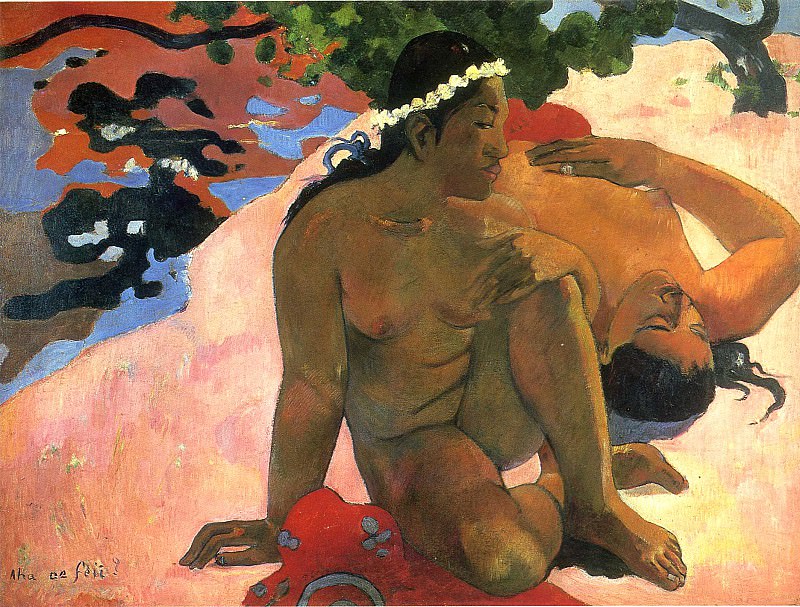Gauguin (12) Paul Gauguin (1848-1903)
Paul Gauguin – Gauguin (12)
Edit attribution
Download full size: 2128×1613 px (0,4 Mb)
Painter: Paul Gauguin
Gauguin was a traveler, a French postmodernist painter, the kind of painter who denied the portrayal of existing reality that the realists painted and the movement of the soul that the impressionists tried to capture, and instead created in order to reveal some immutable laws of the universe peculiar to him. Gauguin traveled extensively in his life. He lived with his mother in Peru until the age of seven, and for the rest of his life he remembered the carelessness, the customs, the climate and experienced in his soul the longing for the south.
A description of Paul Gauguin’s painting Ah, are you jealous?
Gauguin was a traveler, a French postmodernist painter, the kind of painter who denied the portrayal of existing reality that the realists painted and the movement of the soul that the impressionists tried to capture, and instead created in order to reveal some immutable laws of the universe peculiar to him.
Gauguin traveled extensively in his life. He lived with his mother in Peru until the age of seven, and for the rest of his life he remembered the carelessness, the customs, the climate and experienced in his soul the longing for the south. As an adult, a family man, he traveled to Tahiti, where he painted nearly eighty canvases, among them "Ah, Are You Jealous?" which grew out of a scene he saw on the seashore.
Two aboriginal sisters, bathed and settled on the shore, were talking, rejoicing in the sunny, clear day and their own youth. Suddenly a controversial one cut through among the memories, causing one of the girls to crouch on the sand and exclaim loudly: "Ah, you’re jealous!" From this, seen unintentionally, piece of other people’s lives and grew a painting that Gauguin called in his time the best he had ever painted.
The space of the painting seems endless. The blue-black-red spots of the sea merge with the sand and the tree sheltering the girls from the sun. The light-hearted red dresses are thrown off. One of the girls lies on the sand, lazily covering her belly with her hand and squinting her eyes; the other, obviously exclaiming, sits looking at her sister. Her figure is drawn more clearly, one hand on her knee, a wreath of white flowers in her hair, a blue ribbon entwined in it.
Both girls are naked, but not at all embarrassed about it. There is nothing shameful or strange about their nudity in their world; on the contrary, it would be strange to enter the sea with their clothes on. Their bodies shimmer with iridescent bronze, their faces bear all the features typical of their people - a slightly flattened profile, narrow eyes.
Кому понравилось
Пожалуйста, подождите
На эту операцию может потребоваться несколько секунд.
Информация появится в новом окне,
если открытие новых окон не запрещено в настройках вашего браузера.
You need to login
Для работы с коллекциями – пожалуйста, войдите в аккаунт (open in new window).




















COMMENTS: 1 Ответы
Мега отстой. не профессионально.
You cannot comment Why?
The background is a vibrant tapestry of colors. A swirling pattern of abstract shapes in shades of deep red, black, and brilliant blue suggests foliage and water, creating a dynamic contrast with the softness of the human figures and the sun-drenched ground. A hint of green foliage hangs from above, providing shade and framing the scene.
The painting evokes a sense of exoticism and tranquility, capturing the perceived idyllic life of the indigenous people of Tahiti, a theme frequently explored by Gauguin. The women are depicted with dignity and simplicity, their bodies presented in a natural, unidealized manner. The title, Arearea (often translated as Joyful Conversation or Revery), and the inscription at the bottom left, Arearea fae ae ? which can be interpreted as What is Arearea?, suggest a deeper exploration of happiness and the nature of existence within this seemingly paradisiacal environment. The work invites contemplation on themes of beauty, innocence, the exotic, and perhaps the artists own yearning for a simpler, more spiritual life away from Western civilization.